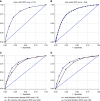Major Bleeding and Risk of Death after Percutaneous Native Kidney Biopsies: A French Nationwide Cohort Study
- PMID: 33060158
- PMCID: PMC7646233
- DOI: 10.2215/CJN.14721219
Major Bleeding and Risk of Death after Percutaneous Native Kidney Biopsies: A French Nationwide Cohort Study
Erratum in
-
Correction: Major Bleeding and Risk of Death after Percutaneous Native Kidney Biopsies: A French Nationwide Cohort Study.Clin J Am Soc Nephrol. 2021 Aug;16(8):1261. doi: 10.2215/CJN.08200621. Clin J Am Soc Nephrol. 2021. PMID: 34362790 Free PMC article. No abstract available.
Abstract
Background and objectives: The risk of major bleeding after percutaneous native kidney biopsy is usually considered low but remains poorly predictable. The aim of the study was to assess the risk of major bleeding and to build a preprocedure bleeding risk score.
Design, setting, participants, & measurements: Our study was a retrospective cohort study in all 52,138 patients who had a percutaneous native kidney biopsy in France in the 2010-2018 period. Measurements included major bleeding (i.e., blood transfusions, hemorrhage/hematoma, angiographic intervention, or nephrectomy) at day 8 after biopsy and risk of death at day 30. Exposures and outcomes were defined by diagnosis codes.
Results: Major bleeding occurred in 2765 of 52,138 (5%) patients (blood transfusions: 5%; angiographic intervention: 0.4%; and nephrectomy: 0.1%). Nineteen diagnoses were associated with major bleeding. A bleeding risk score was calculated (Charlson index [2-4: +1; 5 and 6: +2; >6: +3]; frailty index [1.5-4.4: +1; 4.5-9.5: +2; >9.5: +3]; women: +1; dyslipidemia: -1; obesity: -1; anemia: +8; thrombocytopenia: +2; cancer: +2; abnormal kidney function: +4; glomerular disease: -1; vascular kidney disease: -1; diabetic kidney disease: -1; autoimmune disease: +2; vasculitis: +5; hematologic disease: +2; thrombotic microangiopathy: +4; amyloidosis: -2; other kidney diagnosis: -1) + a constant of 5. The risk of bleeding went from 0.4% (lowest score group =0-4 points) to 33% (highest score group ≥35 points). Major bleeding was an independent risk of death (500 of 52,138 deaths: bleeding: 81 of 2765 [3%]; no bleeding: 419 of 49,373 [0.9%]; odds ratio, 1.95; 95% confidence interval, 1.50 to 2.54; P<0.001).
Conclusions: The risk of major bleeding after percutaneous native kidney biopsy may be higher than generally thought and is associated with a twofold higher risk of death. It varies widely but can be estimated with a score useful for shared decision making and procedure choice.
Keywords: Amyloidosis; Blood Transfusion; Diabetic Nephropathies; Epidemiology and outcomes; Frailty; Hematoma; Hemorrhage; Nephrectomy; Thrombocytopenia; Thrombotic Microangiopathies; anemia; bleeding; kidney biopsy; nationwide data; score.
Copyright © 2020 by the American Society of Nephrology.
Figures



Comment in
-
How Safe Is a Native Kidney Biopsy?Clin J Am Soc Nephrol. 2020 Nov 6;15(11):1541-1542. doi: 10.2215/CJN.14890920. Epub 2020 Oct 15. Clin J Am Soc Nephrol. 2020. PMID: 33060161 Free PMC article. No abstract available.
References
-
- Corapi K, Chen J, Balk E, Gordon C: Bleeding complications of native kidney biopsy: A systematic review and meta-analysis. Am J Kidney Dis 60: 62–73, 2012. - PubMed
-
- Whittier W, Korbet S: Timing of complications in percutaneous renal biopsy. J Am Soc Nephrol 15: 142–147, 2004. - PubMed
-
- Ameda S, Kuroda H, Yamada M, Sato K, Miura S, Sakano H, Shibata T, Uemura N, Abe T, Fujii S, Maeda M, Fujita M, Kobune M, Kato J: Thrombotic microangiopathy due to malignant hypertension complicated with late-onset bleeding after renal biopsy. Rinsho Ketsueki 58: 637–642, 2017. - PubMed
-
- Krejčí K, Černá M, Žamboch K, Orság J, Klíčová A, Zadražil J: Late rupture of lumbar artery as an unusual complication after renal biopsy - case report. Urol Int 98: 112–114, 2017. - PubMed
MeSH terms
LinkOut - more resources
Full Text Sources
Medical

